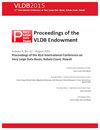Cornet: Learning Spreadsheet Formatting Rules by Example
IF 3.3
3区 计算机科学
Q2 COMPUTER SCIENCE, INFORMATION SYSTEMS
引用次数: 0
Abstract
Data management and analysis tasks are often carried out using spreadsheet software. A popular feature in most spreadsheet platforms is the ability to define data-dependent formatting rules. These rules can express actions such as "color red all entries in a column that are negative" or "bold all rows not containing error or failure". Unfortunately, users who want to exercise this functionality need to manually write these conditional formatting (CF) rules. We introduce Cornet, a system that automatically learns such conditional formatting rules from user examples. Cornet takes inspiration from inductive program synthesis and combines symbolic rule enumeration, based on semi-supervised clustering and iterative decision tree learning, with a neural ranker to produce accurate conditional formatting rules. In this demonstration, we show Cornet in action as a simple add-in to Microsoft's Excel. After the user provides one or two formatted cells as examples, Cornet generates formatting rule suggestions for the user to apply to the spreadsheet.通过示例学习电子表格格式规则
数据管理和分析任务通常使用电子表格软件进行。在大多数电子表格平台中,一个流行的特性是能够定义依赖于数据的格式化规则。这些规则可以表达诸如“将一列中为负数的所有条目涂成红色”或“将不包含错误或失败的所有行加粗”之类的操作。不幸的是,想要使用此功能的用户需要手动编写这些条件格式化(CF)规则。我们介绍Cornet,一个从用户示例中自动学习条件格式规则的系统。Cornet从归纳程序综合中获得灵感,将基于半监督聚类和迭代决策树学习的符号规则枚举与神经排序器相结合,以产生准确的条件格式规则。在这个演示中,我们将展示Cornet作为Microsoft Excel的一个简单插件的作用。在用户提供一个或两个格式化的单元格作为示例之后,Cornet将生成格式化规则建议,供用户应用于电子表格。
本文章由计算机程序翻译,如有差异,请以英文原文为准。
求助全文
约1分钟内获得全文
求助全文
来源期刊

Proceedings of the Vldb Endowment
Computer Science-General Computer Science
CiteScore
7.70
自引率
0.00%
发文量
95
期刊介绍:
The Proceedings of the VLDB (PVLDB) welcomes original research papers on a broad range of research topics related to all aspects of data management, where systems issues play a significant role, such as data management system technology and information management infrastructures, including their very large scale of experimentation, novel architectures, and demanding applications as well as their underpinning theory. The scope of a submission for PVLDB is also described by the subject areas given below. Moreover, the scope of PVLDB is restricted to scientific areas that are covered by the combined expertise on the submission’s topic of the journal’s editorial board. Finally, the submission’s contributions should build on work already published in data management outlets, e.g., PVLDB, VLDBJ, ACM SIGMOD, IEEE ICDE, EDBT, ACM TODS, IEEE TKDE, and go beyond a syntactic citation.
 求助内容:
求助内容: 应助结果提醒方式:
应助结果提醒方式:


